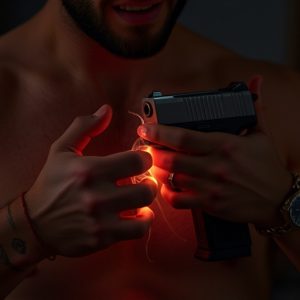Stay Safe with Stun Guns: A Guide to Mechanics, Laws, and Best Practices
Stun guns operate by delivering a high-voltage, low-ampere electrical shock that temporarily disabl…….
Stun guns operate by delivering a high-voltage, low-ampere electrical shock that temporarily disables muscle and nerve function. Contrary to common misconceptions, they do not need to make deep contact with the skin to be effective; an electrical pathway to the body is sufficient, even through slightly conductive clothing. The effectiveness of stun guns can be influenced by battery condition, moisture on the skin, and the type of fabric between the device and the target. While laws regarding stun gun possession and use vary by jurisdiction, it's crucial to adhere to local regulations to avoid legal issues. Safe handling includes proper storage in a secure, dry place to prevent accidental discharges, and understanding the technical aspects, limitations, and legal considerations of the device is essential for responsible use. It's important to remember that stun guns do not necessarily have to touch skin to incapacitate an attacker, and effective use requires both technical knowledge and compliance with local laws. Proper training is vital for users to utilize these devices safely and effectively in self-defense situations.
When it comes to personal safety devices, stun guns are a contentious and effective tool for self-defense. This article delves into the mechanics of stun guns, their legal use, and the critical aspect of handling them safely to prevent accidents. We’ll explore how they function, the importance of situational awareness, and the necessity of proper training. A common question arises regarding their efficacy: Does a stun gun have to touch skin to be effective? The answers may surprise you. Join us as we unravel these safety tips and dispel myths surrounding stun guns, ensuring you are well-informed and prepared should the need arise.
Understanding Stun Gun Mechanics and Their Effectiveness
When considering the effectiveness and safe application of stun guns, understanding their mechanics is crucial. Stun guns are non-lethal self-defense tools that incapacitate an attacker by delivering a high-voltage, low-ampere electrical charge. This charge disrupts the normal function of the muscles and nerves of the target individual, leading to a loss of balance and motor control. The effectiveness of a stun gun is contingent upon several factors, including proper use, battery strength, and the presence of moisture on the skin, which can conduct the electric current more effectively.
One common question regarding stun guns is whether they need to make direct contact with the skin to be effective. Contrary to some misconceptions, it is not necessary for a stun gun to penetrate the skin deeply; rather, it requires an electrical pathway to the body. The device can be held against clothing, and if the clothing is slightly conductive, the stun gun’s prongs can deliver the charge through the fabric to the assailant. This aspect makes stun guns versatile in self-defense situations where direct contact might not be possible or desirable. It’s important to handle a stun gun with respect for its power and to practice with the device to ensure proper technique and safety, as improper use could lead to unintended outcomes. Users should always familiarize themselves with local laws and regulations regarding the possession and use of stun guns, as these can vary by jurisdiction.
Legal Considerations When Owning and Using a Stun Gun
Prior to owning and using a stun gun, it is imperative to familiarize oneself with the legal framework governing their possession and application in your jurisdiction. Laws regarding stun guns vary significantly across different regions; therefore, an individual must first verify if stun guns are permitted within their locale. In some areas, there may be restrictions on where you can carry a stun gun, and certain establishments might prohibit them entirely. Additionally, understanding the legal distinction between using a stun gun for self-defense versus unlawful aggression is crucial. It’s a common question whether a stun gun has to touch skin to be effective, and the answer often lies in the specific laws of your state or country. In some regions, the device must make contact with an individual, while in others, it can be designed for drive-stun applications where no physical contact is necessary. Always ensure compliance with local regulations, as improper use can lead to legal repercussions, including criminal charges. Safety and legality are paramount when considering the use of a stun gun; therefore, thorough research and consultation with legal experts are strongly advised before purchase or deployment.
Safe Handling and Storage of Stun Guns for Prevention of Accidental Discharge
When integrating stun guns into your personal safety plan, it’s crucial to prioritize safe handling and storage to prevent accidental discharge. One of the primary concerns with stun gun use is ensuring that it does not activate unintentionally. To mitigate this risk, always keep the stun gun in a secure, dry place, away from direct sunlight or moisture, as these conditions can compromise its functionality. The device should be stored in its original case or a similar protective container, and it’s essential to ensure that the safety switch is engaged when not in use. Additionally, regularly inspect the stun gun for any signs of wear or damage that could lead to an unintended activation. It’s also important to understand that a stun gun does not necessarily have to make contact with the skin to be effective; it emits an electrical charge that can incapacitate an assailant from a distance. However, direct contact may increase the effectiveness of the device by delivering a more potent shock. Always follow local laws and regulations regarding stun gun use, as they can vary by jurisdiction. Proper storage and handling prevent accidental discharge, ensuring your safety and the safety of those around you.
The Importance of Situational Awareness and Proper Training with Stun Guns
When considering stun gun safety, situational awareness emerges as a critical factor in ensuring one’s personal safety effectively. A vigilant individual is less likely to encounter unexpected threats or find themselves in a situation where a stun gun might be necessary for defense. Being aware of one’s surroundings allows for the early detection of potential dangers, providing more options for response and escape before escalation occurs. This heightened awareness can also help users understand when it is appropriate to deploy their stun gun and avoid unnecessary use or confrontation.
Proper training with a stun gun is indispensable for its effective and safe use. It’s a common question whether a stun gun has to touch skin to be effective, and the answer lies in the device’s design and capabilities. While direct contact can maximize the effectiveness of a stun gun by delivering a potent electrical charge that can incapacitate an assailant, it is not always required for the device to function. Training equips users with the knowledge of how their specific model operates under various conditions and from different distances. Understanding the limitations and proper application of a stun gun is crucial. It ensures that the user employs the device in a manner that minimizes risk to themselves and others, and adheres to local laws and regulations. Comprehensive training also covers scenarios and decision-making processes that can aid in avoiding harmful situations or using the stun gun only when absolutely necessary. Safe handling and familiarity with the legal implications of using a stun gun are as important as understanding its technical aspects, making it a comprehensive learning experience for potential users.
Addressing Misconceptions: Does a Stun Gun Have to Touch Skin to be Effective?
When it comes to understanding the effectiveness of a stun gun, one common misconception is that it must make direct contact with an individual’s skin to deliver a shock. In reality, the efficacy of a stun gun, also known as a stun baton or electric prodder, does not solely rely on skin-to-skin contact. These devices are designed with two or more electrodes; one at each end of the unit. When activated, a high-voltage, low-ampere electrical charge is emitted between these electrodes. This charge can be effectively delivered through light clothing, such as a jacket or pants, which is why it’s crucial to be aware that a stun gun can be used even if there is a barrier between the device and the assailant. It’s important for users to comprehend this aspect of stun guns to ensure they can respond effectively in self-defense situations. The voltage allows the current to jump the gap created by the fabric, which can incapacitate an attacker. However, the thinner or more conductive the material, the better the conduction will be. Thick leather or heavy-duty materials may impede the stun gun’s effectiveness, so users should consider this when choosing what to wear for optimal defense. Understanding that a stun gun does not require direct skin contact can be a game-changer in personal safety scenarios, and it’s essential for users to be well-informed about how these devices function to use them responsibly and effectively.


